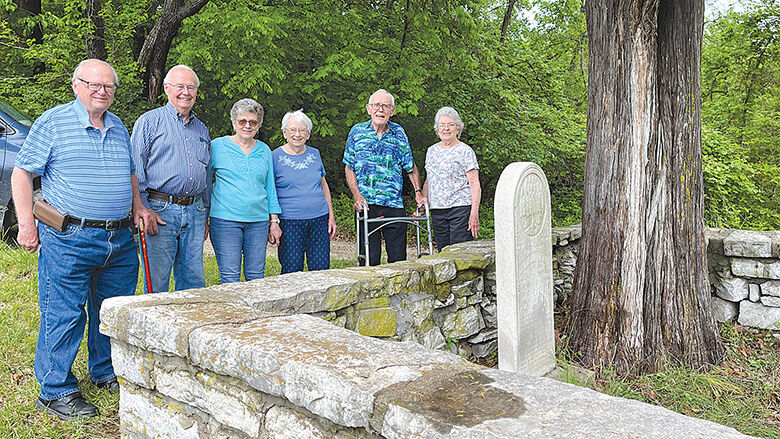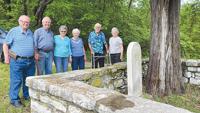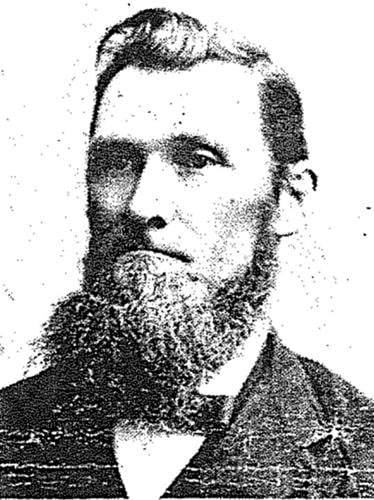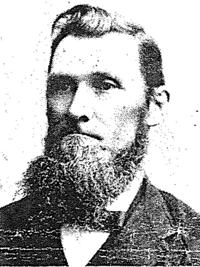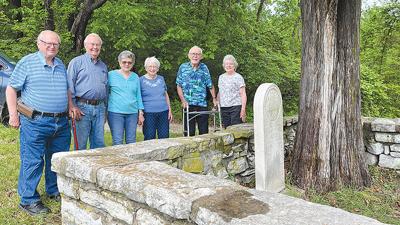In a small enclosure on the Jeude family home just north of Pevely, a single stone marks the graves of Herman and Agnes Jeude, a young couple who were brutally murdered and their baby injured and left for dead on a Sunday afternoon in 1844.

Herman Jeude
Their family has spent 180 years struggling to come to terms with the terrible tragedy and its equally horrifying aftermath: the lynching of a suspect, an enslaved Black man, by a group of angry citizens.
“People ask about it (the gravesite) all the time,” said Al Jeude, 88, the couple’s great-great-grandnephew. “You always like to share the story, until you get to the part about who did it. None of the family took part in (the lynching), but we are still associated with it.”
Herman Jeude and his brother, John Jeude, came to the area as German immigrants in 1840 and opened a leatherworking shop.
“None of us know quite how they ended up here,” said Al’s sister, Bernice Jeude Feldkamp, 93, who lives on the Pevely-area property along with her son, Dennis. “One of our relatives found some information about (Herman and Agnes’) wedding in Ohio. My theory is that they came through New York, but they also could have come up the river by boat. We just don’t know.”
Family legend, passed down through four generations as oral history, tells of the attack, which left the couple dead and their infant son badly injured.
Ann Vazquez, 61, who lives part time at Summer Set Lake near De Soto, is the great-great-granddaughter of that baby, who survived and was nursed back to health by a local family before being adopted and raised by his surviving uncle John, from whom the other Jeude branch is descended.
“I think it’s important to tell this story,” Vazquez said.
A sad Sunday
The basic facts of the case are documented, although information is scanty and based solely on reports by non-professionals.
“There were no police reports, no physical evidence like fingerprints taken,” Vazquez said. “That does make it tough. Just about everything we know about it comes from oral history.”
“We all heard the story from our father,” Bernice said.
Although there were no eyewitness testimony or official reports about the incident, there are several published accounts, based on oral history and written down many years after the fact. All give the same basic outline:
On a spring Sunday afternoon in 1844, 28-year-old Herman Jeude was working in his boot- and shoe-making shop when he was attacked and killed by someone wielding an ax. His wife, Agnes, met the same fate shortly afterward in the adjacent house, and their 18-month-old son, Herman Jr., was struck a blow to the head with the ax but only injured.
A driver on his way south from St. Louis discovered the crime scene, with the crying, bloody child, a still-warm fire in the shop and dishes set out for lunch in the house kitchen.
The man quickly rode to Joshua Herrington’s nearby home, where a local man named Cook had dropped by on his way to church. Cook had earlier stopped at the Jeude shop for a pair of boots he had ordered and said while he was there he had encountered “a Negro slave” who was picking up some shoes.
Once the injured baby was seen to, a group of local men assembled and, led by a local physician named Doc West, went to the nearby farm where the enslaved man was working on loan from his owner in St. Louis. They questioned him briefly, and then he was taken to Hillsboro where the county sheriff placed him in a cell. After several hours, though, the group of angry citizens used heavy timbers to break down the cell door and transported the man back to the Jeude property, where he was hanged.
“It was a real rush to justice,” Vazquez said. “He could very well have been the one who killed them, but we can’t know. They might have hanged an innocent man for the crime, and there may have been someone else who got away with it.”
Little Herman was nursed back to health in the Herrington household. His uncle, John, came to visit and fell in love with the Herringtons’ daughter, Margrette. They married and raised Herman, who went on to have eight children, including Vazquez’ great-grandfather.
John and Margrette had several children of their own, including August, the grandfather of the nine Jeude siblings. Seven are still living: Alveda (Bill) Ehrlich of Arnold, Bernice Feldkamp, Bill (Elaine) Jeude of Pevely, Al (Sue) Jeude and three sisters who live out of town.
As the years went by, the story passed into history. The Jeude house burned and was rebuilt a short distance away; the railroad came in 1902 and bisected the property; more acreage was lost to I-55 in the early 1970s.
Bill said he remembers the big stone Herman and John used while working the hides for their business.
“Oh, it was probably 4 feet by 8 feet,” Bill recalled. “(Later) it was used as like a front step, and then it was bulldozed into the basement hole after the house burned.”
A dismaying difference
Nearly two hundred years after the fact, anyone reading accounts of the murders can’t help but come up against the glaring difference in the way the victims and their suspected killer were portrayed. It is downright uncomfortable to read.
The white people in the story are called “friendly, honest, industrious, cleanly dressed, and intelligent,” while the enslaved man – whose name is never even given – is described as “ragged, slovenly, brutal, and treacherous.”
“He was judged, his character, his honesty, based solely on his appearance,” Vazquez said. “And maybe all he did was come into the store to pick up a pair of shoes.”
Bill said history doesn’t paint a very nice picture of those who were involved with the lynching.
“They did a book a while back about all the sheriffs of Jefferson County, going way back,” he said. “Their terms of service, their accomplishments. The entry for that one is blank.”
Keeping history alive
Despite its early tragedy, the Jeude family remains a tight-knit clan, and the different branches have enjoyed getting to know one another.
“Ann showed up at my door one day,” Bernice said. “Just out of the blue. She talked about how she lived in St. Louis as a child, and her mom would always point out the gravesite when they passed it on the way south.”
The Jeude siblings and their cousins have made sure the grave’s story remains part of family lore. Now three and four generations removed from the event, the Jeude grandchildren and great-grandchildren know about it as just a story of long ago.
Vazquez said she hopes telling her family’s story can have positive results.
“I want to tell it from the angle of how an oral story is passed from generation to generation,” she said. “And about how we, with the newer generations, can look at this and learn from the past to hopefully not repeat in the future. I want the story to be told in a way that makes people think about the impact words can have.
“We still use words to describe people who are different. It’s hard, seeing how some people are seen as lesser. The slave is never named; he didn’t matter enough to them. But he was a person also, whether he did it or not. Even if this person did kill them, I am very saddened about how so-called ‘justice’ was served that day.”
“We like to think we’ve come a long way since 1844, but we still make assumptions about people, and that can have far-reaching consequences.
“It’s very troubling.”



